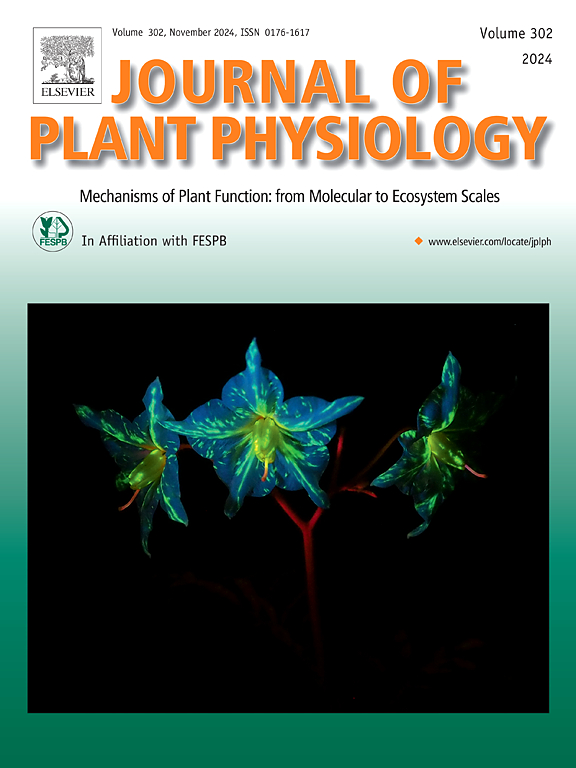Positive influence of selenium on the modulation of ascorbate-glutathione cycle in salt stressed Setaria italica L
IF 4
3区 生物学
Q1 PLANT SCIENCES
引用次数: 0
Abstract
Soil salinity is a significant abiotic factor affecting crop yield and global distribution, hence selecting salt-tolerant crop species is crucial for food security. Foxtail millet is a resilient crop suitable for hilly, salinity, and drought-prone areas due to its ability to withstand environmental stressors. In this study, foxtail millet was subjected to high NaCl concentrations (150 mM and 200 mM) and selenium (1 μM, 5 μM, and 10 μM) as a stress mitigator. Increased salinity in foxtail plants hampered the growth with decreased pigment levels, increased H₂O₂ levels (153.6%), lipid peroxidation (32.1%), and electrolyte leakage (155.5%). The application of 1 μM Se positively influenced the root-to-shoot ratio (R) (59.2%), photosynthetic pigments, phenolic content (25.1%), flavonoid content (7%) and hence the antioxidant potential of the salt stressed plants there by decreasing the H₂O₂ levels (26.8%) and suggesting a greater ability to scavenge radicals. Both NaCl and Se induced the AsA-GSH pathway. Se supplementation significantly improved AsA-GSH pathway components such as AsA/DHA (40.8%) and GSH/GSSG ratios (39.6%) in salt-stressed foxtail millet, reducing oxidative stress and efficiently neutralizing H₂O₂. Gene expression validation confirmed that SiAPX, SiDHAR, SiMDHAR, and SiGR showed significant upregulation with 1 μM Se application in salt-stressed foxtail millet plants.
However, higher Se concentrations (5 μM and 10 μM) led to a reduced fresh weight along with R, increased the MDA and H₂O₂ levels, and did not positively contribute to osmolyte accumulation or improve the AsA/DHA and GSH/GSSG ratios. Elevated Se levels also led to a decreased antioxidant potential. Among the enzymes of the AsA-GSH cycle, higher Se concentrations negatively affected APX, DHAR, MDHAR, and GR activities, indicating stress aggravation rather than mitigation at elevated doses.
硒对盐胁迫下狗尾草抗坏血酸-谷胱甘肽循环调节的积极影响
土壤盐分是影响作物产量和全球分布的重要非生物因素,因此选择耐盐作物品种对粮食安全至关重要。谷子是一种适应性强的作物,由于其承受环境压力的能力,适合丘陵、盐碱地和干旱易发地区。以谷子为研究对象,采用高NaCl浓度(150 mM和200 mM)和硒浓度(1 μM、5 μM和10 μM)作为胁迫缓解剂。盐度升高对草叶生长的影响主要表现为色素水平降低、h2o2水平升高(153.6%)、脂质过氧化(32.1%)和电解质泄漏(155.5%)。1 μM Se处理显著提高了盐胁迫植株的根冠比(R)(59.2%)、光合色素、酚类含量(25.1%)、类黄酮含量(7%),降低了h2o2水平(26.8%),提高了抗氧化能力。NaCl和Se均可诱导AsA-GSH通路。硒显著提高了盐胁迫下谷子AsA-GSH通路组分AsA/DHA(40.8%)和GSH/GSSG(39.6%),降低了氧化应激,有效中和了h2o2。基因表达验证证实,盐胁迫下谷子SiAPX、SiDHAR、SiMDHAR和SiGR在1 μM Se处理下显著上调。然而,较高的Se浓度(5 μM和10 μM)导致鲜重随R降低,MDA和H₂O₂水平升高,但对渗透物积累或AsA/DHA和GSH/GSSG比值没有积极影响。硒水平升高也会导致抗氧化能力下降。在AsA-GSH循环的酶中,较高的Se浓度对APX、DHAR、MDHAR和GR活性有负面影响,表明在高剂量下胁迫加重而不是缓解。
本文章由计算机程序翻译,如有差异,请以英文原文为准。
求助全文
约1分钟内获得全文
求助全文
来源期刊

Journal of plant physiology
生物-植物科学
CiteScore
7.20
自引率
4.70%
发文量
196
审稿时长
32 days
期刊介绍:
The Journal of Plant Physiology is a broad-spectrum journal that welcomes high-quality submissions in all major areas of plant physiology, including plant biochemistry, functional biotechnology, computational and synthetic plant biology, growth and development, photosynthesis and respiration, transport and translocation, plant-microbe interactions, biotic and abiotic stress. Studies are welcome at all levels of integration ranging from molecules and cells to organisms and their environments and are expected to use state-of-the-art methodologies. Pure gene expression studies are not within the focus of our journal. To be considered for publication, papers must significantly contribute to the mechanistic understanding of physiological processes, and not be merely descriptive, or confirmatory of previous results. We encourage the submission of papers that explore the physiology of non-model as well as accepted model species and those that bridge basic and applied research. For instance, studies on agricultural plants that show new physiological mechanisms to improve agricultural efficiency are welcome. Studies performed under uncontrolled situations (e.g. field conditions) not providing mechanistic insight will not be considered for publication.
The Journal of Plant Physiology publishes several types of articles: Original Research Articles, Reviews, Perspectives Articles, and Short Communications. Reviews and Perspectives will be solicited by the Editors; unsolicited reviews are also welcome but only from authors with a strong track record in the field of the review. Original research papers comprise the majority of published contributions.
 求助内容:
求助内容: 应助结果提醒方式:
应助结果提醒方式:


